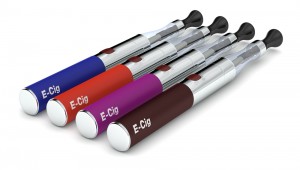
Electronic cigarettes (e-cigarettes) are a range of products that deliver vapour which typically contains nicotine (although zero-nicotine solutions are available). The name is misleading because some products are mechanical rather than electronic, and because they are not cigarettes. While first-generation products were designed to be visually similar to cigarettes, second- and third-generation products are visually distinctive and come in a variety of shapes and sizes. Critically, these products do not contain tobacco, and are therefore intended to deliver nicotine without the harmful constituents of tobacco smoke.
There has been rapid growth in the popularity and use of e-cigarettes in recent years, accompanied by growth in their marketing. At present they are relatively unregulated in many countries, although countries are introducing various restrictions on their availability and marketing. For example, a ban on sales to under-18s will be introduced in England and Wales in 2015.
These products have stimulated considerable (and often highly polarized) debate in the public health community. On the one hand, if they can support smokers in moving away from smoking they have enormous potential to reduce the harms associated with smoking. On the other hand, the quality and efficacy of these products remains largely unknown and is likely to be highly variable, and data on the long-term consequences of their use (e.g., the inhalation of propylene glycol vapour and flavourings) is lacking. There is also a concern that these products may re-normalise smoking, or act as a gateway into smoking.

E-cigarettes and teenagers: a gateway to smoking tobacco or a safer alternative?
Methods
This study reports the results of a survey conducted by Trading Standards in the North-West of England on 14 to 17 year-old students. The survey focuses on tobacco-related behaviours, and a question on access to e-cigarettes was introduced in 2013. This enabled identification of factors associated with e-cigarette use among people under 18 years old.
The study used data from the 5th Trading Standards North West Alcohol and Tobacco Survey among 14 to 17 year-olds in North-West England, conducted in 2013. The questionnaire was made available to secondary schools across the region through local authority Trading Standards departments, and delivered by teachers during normal school lessons. Compliance was not recorded, and the sample was not intended to be representative but to provide a sample from a range of communities.
The survey consisted of closed, self-completed questions covering sociodemographic variables, alcohol consumption and tobacco use. There were also questions on methods of access to alcohol and tobacco, as well as involvements in violence when drunk. E-cigarette access was assessed by the question “Have you ever tried or purchased e-cigarettes?”.

The study used data from the 2013 North West Alcohol and Tobacco Survey, which asked 14 to 17 year-olds lots of questions about their drinking and smoking habits (including their e-cigarette use).
Results
A total of 114 schools participated, and the total dataset included 18,233 participants, of which some were removed for missing data or spoiled questionnaires (e.g., unrealistic answers), so that the final sample for analysis was 16,193. Some of the main findings of the survey included:
- In total, 19.2% of respondents reported having accessed e-cigarettes, with this being higher in males than females, and increasing with age and socioeconomic deprivation.
- Level of e-cigarette access was higher among those who had smoked, ranging from 4.9% of never smokers, through 50.7% of ex-smokers, 67.2% of light smokers and 75.8% of heavy smokers.
- E-cigarette use was associated with alcohol use, with those who drank alcohol more likely to have accessed e-cigarettes than non-drinkers, as well as with smoking by parents/guardians.

Nearly 1 in 5 of the young people surveyed, reported that they had ‘accessed’ e-cigarettes.
Conclusion
The authors conclude that their results raise concerns around the access to e-cigarettes by children, particularly among those who have never smoked cigarettes. They argue that their findings suggest that the children who access e-cigarettes are also those most vulnerable to other forms of substance use and risk-taking behavior, and conclude with a call for the “urgent need for controls on e-cigarette sales to children”. The study has some important strengths, most notably its relatively large size, and ability to determine which respondents were living in rich and poor areas.
Understanding the determinants of e-cigarette use, and patterns of use across different sections of society, is important to inform the ongoing debate around their potential benefits and harms. However, it is also not clear what this study tells us that was not already known. The results are consistent with previous, larger surveys, which show that young people (mostly smokers) are trying e-cigarettes. Critically, these previous surveys have shown that while some young non-smokers are experimenting with electronic cigarettes, progression to regular use among this group is rare. Product labels already indicate that electronic cigarettes are not for sale to under-18s, and in 2014 the UK government indicated that legislation will be brought forward to prohibit the sale of electronic cigarettes to under-18s in England and Wales (although at present no such commitment has been made in Scotland).

This study does not add anything significant to our knowledge about e-cigarettes.
Limitations
There are a number of important limitations to this study:
- As the authors acknowledge, this was not meant to be a representative survey, and the results can therefore not be generalized to the rest of the north-west of England, let alone the wider UK.
- As a cross-sectional survey it was not able to follow up individual respondents, for example to determine whether never smokers using e-cigarettes progress to smoking. This problem is common to most e-cigarette surveys to date.
- The question asked does not tell us whether the participants actually used the e-cigarette they accessed, or what liquid was purchased with the e-cigarette (e.g., the concentration of nicotine). Zero-nicotine solutions are available, and there is evidence that these solutions are widely used by young people.
- The results are presented confusingly, with numerous percentages (and percentages of percentages) reported. For example, 4.9% of never smokers reported having accessed e-cigarettes, but this is less than 3% of the overall sample (fewer than 500 out of 16,193 respondents). This is potentially an important number to know, but is not reported directly in the article.
Summary
This study does not add much to what is already known. Young people experiment with substances like tobacco and alcohol, and as e-cigarettes have become widely available they have begun to experiment with these too. However, to describe electronic cigarette use as “a new drug use option” and part of “at-risk teenagers’ substance using repertoires” is probably unnecessarily alarmist, given that:
- There is evidence that regular use of e-cigarettes among never smokers is negligible
- There is little evidence of e-cigarette use acting as a gateway to tobacco use
- The likelihood that e-cigarette use will be associated with very low levels of harm

It’s alarmist to suggest that e-cigarettes are a “new drug use option” for teenagers, without the evidence to back up this claim.
Links
Primary reference
Huges K, Bellis MA, Hardcastle KA, McHale P, Bennett A, Ireland R, Pike K. Associations between e-cigarette access and smoking and drinking behaviours in teenagers. BMC Public Health 2015; 15: 244. doi: 10.1186/s12889-015-1618-4
Other references
Young Persons Alcohol and Tobacco Survey 2013. Lancashire County Council’s Trading Standards.


RT @Mental_Elf: E-cigarettes and teenagers: cause for concern? http://t.co/bPvyXmgY9f
E-cigarettes and teenagers: cause for concern?: Marcus Munafò appraises a recent cross-sectional survey, which… http://t.co/hVAKPY1nTX
Raluca Lucacel liked this on Facebook.
E-cigarettes and teenagers: cause for concern? http://t.co/8OsCGxflsN #MentalHealth http://t.co/zFdC0aKIjd
Bethan Davies liked this on Facebook.
RT @Mental_Elf: Today @MarcusMunafo looks at associations between e-cigarette access and smoking & drinking behaviours in teenagers http://…
A nice level headed assessment from @MarcusMunafo on e-cigs & alcohol. What does it tell us? http://t.co/Y1nKAd7FaM via @Mental_Elf
@CaeruleanSea @MarcusMunafo @Mental_Elf that public health is not monolithic.”Free your mind, and the rest will follow.”-En Vogue
@jgitchell @MarcusMunafo @Mental_Elf I agree, did you see the blog from Louise Ross about ecigs & mental health?
@CaeruleanSea @MarcusMunafo @Mental_Elf No–I actually slept for a bit and am not caught up. Can you pls send link? Pretty pls?
@jgitchell @MarcusMunafo @Mental_Elf Already did ;)
@CaeruleanSea @MarcusMunafo @Mental_Elf 10Q! Just skimmed; only question: where’s the dang cloning machine for more Louise’s–LOTS more.
@jgitchell @MarcusMunafo @Mental_Elf She’s pretty infectious actually, endless respect for her.
@CaeruleanSea @MarcusMunafo @Mental_Elf but is she on the twittersphere? I can’t find her? Oh, maybe she has actual work to do????
@jgitchell @MarcusMunafo @Mental_Elf haha @grannylouisa
@jgitchell @MarcusMunafo @Mental_Elf That woman is astonishing http://t.co/U30f47rG6f & was firmly against vaping two years ago.
@CaeruleanSea @Hifistud @MarcusMunafo @Mental_Elf Interesting how UK docs are much more supportive of vaping. Wish it were that way here.
http://t.co/6rH9PQ51hg compare this to the hysteria in the @DailyMirror recently about #ecig use by teens. Journalists could learn a lot!
It’s alarmist to suggest that e-cigs are a “new drug use option” for teenagers, without evidence to back up claim http://t.co/bPvyXlZnhH
Hi @JamesTGallagher Any thoughts on our blog of the e-cigarettes & teenagers research you covered recently? http://t.co/bPvyXmgY9f
Morning @doctorblooz Any thoughts on our blog of the recent e-cigarettes & teenagers research? http://t.co/bPvyXlZnhH
Good summary article on e-cigarette use in young people from @Mental_Elf http://t.co/N45FJtQcmA
E-cigarettes: a gateway to smoking tobacco for young people, or a safer alternative? http://t.co/bPvyXlZnhH #ecigs #vaping #teenagers
@BSMC_UWE “@Mental_Elf: E-cigarettes: a gateway to smoking tobacco for young people, or a safer alternative? http://t.co/3JyxVZmz4j“
Great blog by @MarcusMunafo from @BristolTARG about e-cigarettes and teenagers http://t.co/bPvyXlZnhH
RT @Mental_Elf: Hi @andrewgregory Any thoughts on our blog of the e-cigarettes & teenagers research you covered recently? http://t.co/bPvyX…
This is really good from @Mental_Elf : E-cigarettes and teenagers: cause for concern? http://t.co/c4XKqYQV3s
@MarkOneinFour @Mental_Elf no it’s not, the conclusions and the numbers don’t match. Should say smokers are switching.
North West England survey finds nearly 1 in 5 students (14 to 17 y-o) reported that they had ‘accessed’ e-cigarettes http://t.co/bPvyXlZnhH
E-cigarettes and teenagers: cause for concern? http://t.co/oAQRrZ89d4 via @sharethis
Don’t miss: E-cigarettes and teenagers: cause for concern? http://t.co/bPvyXlZnhH #EBP
Mental Elf: E-cigarettes and teenagers: cause for concern? http://t.co/SmeaK0nr9I
RT @Mental_Elf: Teenagers and e-cigarettes http://t.co/bPvyXlZnhH @MarcusMunafo appraises the UK survey, which recently hit the headlines
ICYMI: My @Mental_Elf blog on a recent survey of e-cigarettes and young people: http://t.co/IWNOEpwZrP
@MarcusMunafo @Mental_Elf Agree on alarmism, but they have no utility except to feed the addition they create, thus wrong to sell to kids.
RT @HealthwatchTame: NW England survey finds nearly 1 in 5 students (14 to 17) reported that had ‘accessed’ e-cigarettes http://t.co/6V2zao…
NW England survey finds nearly 1 in 5 students (14 to 17) reported that had ‘accessed’ e-cigarettes http://t.co/NlqNQ368xt via @Mental_Elf
[…] http://www.thementalelf.net/mental-health-conditions/substance-misuse/e-cigarettes-and-teenagers-cau… […]
[…] E-Cig use among youth who do not currently smoke regular cigarettes is as high as claimed by some (see another of our blog posts), it should not be difficult to investigate this research […]